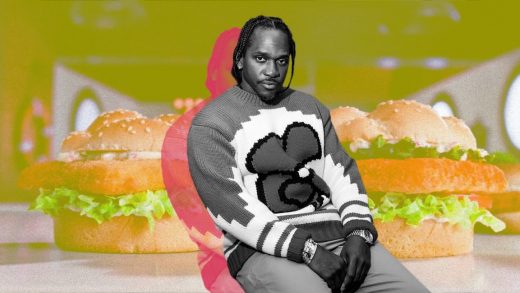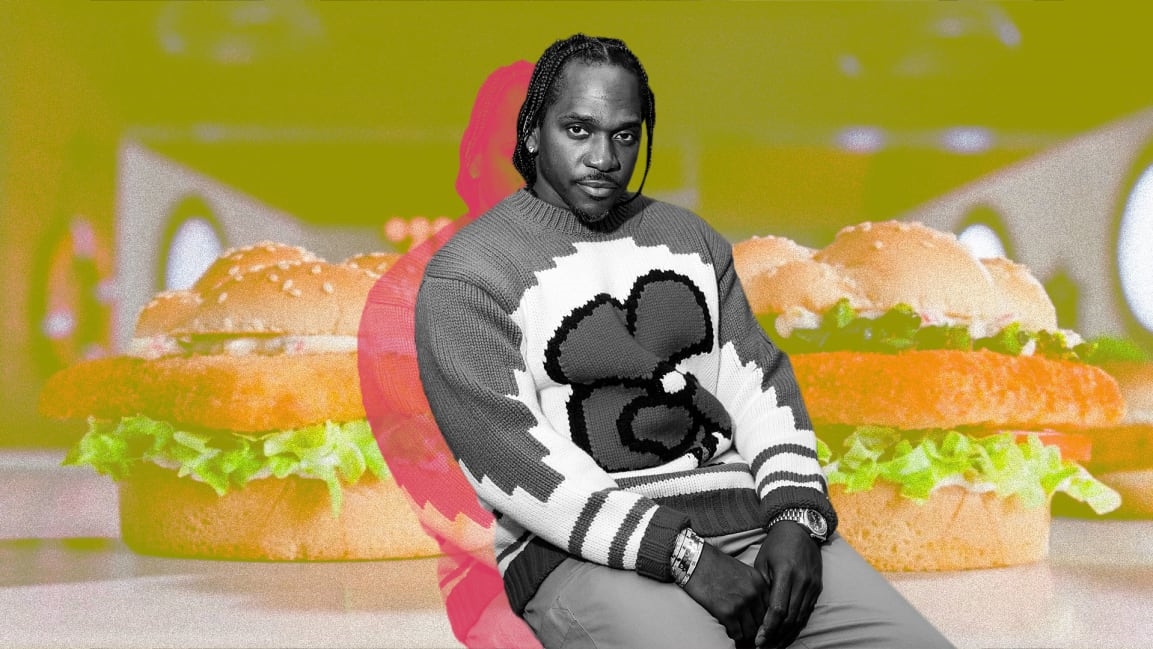Pusha T, Arby’s, and why more brands should be willing to pick a fight
Like any worthwhile surprise, the latest rap diss track came out of seemingly nowhere. On March 21, rapper Pusha T dropped “Spicy Fish Diss,” which lit up the internet immediately. This time Pusha wasn’t aiming his ire at Drake or any other rapper, but instead at McDonald’s and its Filet-O-Fish sandwich, all on behalf of fast-food underdog Arby’s. If this sounds at all bonkers, welcome to pop culture in 2022.
What made this even more compelling was that Pusha was not just a paid spokesattacker or a particularly passionate consumer of fast-food fried fish. No, Pusha was apparently relishing this project to continue his claim that he wrote—and was underpaid for—McDonald’s global tagline and song “I’m Lovin’ It,” which launched in 2003. Pusha told Rolling Stone this week that his spicy take was inspired by resentment over lack of credit and payment. “I did it at a very young age, at a very young time in my career where I wasn’t asking for as much money and ownership,” he said. “It’s something that’s always dug at me later in life like, ‘Dammit, I was a part of this and I should have more stake.’ It was like half a million or a million dollars for me and my brother—but that’s peanuts for as long as that’s been running.”
“I’m the reason the whole world love it, now I gotta crush it/Filet-O-Fish is sh*t/You should be disgusted/How dare you sell a square fish asking us to trust it/A half slice of cheese, Mickey D’s on a budget?”
Coming just over a month after his latest Ye-produced single “Diet Coke,” (which was definitely not a branded track), the overall online reaction to “Spicy Fish Diss” was Supa Hot Fire-ing across social media. Fans were, um, lovin’ it. According to marketing analytics firm Apex Marketing, within just a couple of days, the song had generated $8 million in advertising value for the brand.
As a single piece of advertising, this is a bonafide hit. Brands continue to pan for pop cultural gold in the hopes that it’ll get them any attention, and you could do much worse than enlisting the world’s preeminent diss-track rapper to take a swing at your industry’s largest player. In evaluating it, ad strategy heads have spent the week asking themselves, Why this celeb? Why this brand? Is there a genuine pop culture insight here? Is the brand appropriating pop culture or participating?
“Spicy Fish Diss” answers all of these pretty emphatically while effectively tapping into the cultural alignment between an industry that has historically been unafraid to diss rivals—from Where’s The Beef? to Burger King’s brilliant Whopper Detour—and a category of music where diss tracks are an established genre. It participates in the culture by allowing itself to be used as a tool by Pusha T to inflict his own version of revenge for a decades-old resentment. You could also say that Arby’s isn’t even new to using hip-hop hype as a boost in cultural clout, if we count the Pharrell Grammys Tweet of 2014.
Hey @Pharrell, can we have our hat back? #GRAMMYs
— Arby’s (@Arbys) January 27, 2014
OKAY, BUT WHAT ABOUT . . .
All that said, let’s indulge on why this may not be the fast-food finishing move that it might initially appear to be. First, the backstory. As previously stated, Pusha told Rolling Stone that the inspiration was his resentment (real or perceived) over underpayment for a McDonald’s jingle 20 years ago, and not solely the tasty delights of Arby’s fish sandwich. One senior ad exec told me that almost any CMO would see this as a distraction. Arby’s CMO Patrick Schwing will have to balance between the cool-kid attention for pulling off this marketing coup and the risk that all the love for Pusha redirects the spotlight away from the fact that the point here is supposed to be that Arby’s has what is reputedly an excellent new fish sandwich that you should try. That, and all the chatter about how Pusha snuck a coke reference into his ad.
Second, and more importantly, this is the year 2022. In the very recent past, McDonald’s has given us BTS tote bags and Saweetie N’ Sour sauce, while Popeye’s served up Megan Thee Stallion Hottie Sauce. Where’s the Pusha-themed merch drop, Arby’s? One of the genius aspects of the McDonald’s Famous Meals is how it’s coordinated with original products, music, social media, and more.
Third, let’s just talk about the Filet-O-Fish as the focal point here. I get that Arby’s is trying to sell their own fish sandwich. But you’re the 15th-ranked fast-feeder in America, taking aim at the clown-faced behemoth at the top—and you’re not even using one of its top sellers as ammunition? It’s like using Bill Wennington to diss the ’98 Bulls. Should Arby’s, which, after all, is generally oriented around its “We have the meats” campaign, have used the spicy fish sandwich launch to attack McDonald’s burgers?
MORE TENSION, PLEASE
Seven-foot Canadian NBA role players aside, Arby’s obviously got a lot incredibly right here. Not only because it nudges us dangerously closer to the commercial jingle-dominated future predicted by Demolition Man in 1993, but also in its creative use of tension to gain our attention. It’s an age-old tactic, but one that simply isn’t used enough. When Coke and Pepsi fight in public, it boosts both brands’ visibility and the audience’s interest in what will happen next. Were you and I—much less Hypebeast, GQ, Complex, and Rolling Stone—talking about Arby’s two weeks ago? Exactly.
Our human brains are wired for stories, and the best stories have tension. It’s conflict that makes the resolution interesting. Not enough marketers embrace tension to really tell us who they are or what they—and their product—are about. There are always a few examples sprinkled throughout the years, beyond even soda and burgers, and often it’s this work (if done well) that gets us talking. The long-running Mac versus PC campaign is arguably one of Apple’s best and most beloved. Samsung turned the tables on Apple years later, and it added more personality to its brand proposition. More recently, when Neil Young pulled his entire catalog off Spotify in protest of Joe Rogan in January, Apple Music quickly put out tweets and push notifications declaring itself “the home of Neil Young,” and put a “We Love Neil” playlist at the front of its browse section, all of which was covered by the culture and tech press like it was the latest move in a brand beef. Because it was.
The home of Neil Young.
Listen to his entire catalog on Apple Music: https://t.co/sUGtz4JbB9 pic.twitter.com/YgRMygUqhi
— Apple Music (@AppleMusic) January 28, 2022
That tension doesn’t even need to be directed at a specific competitor. Witness how Ben & Jerry’s uses everything from podcasts to new flavors to tap into the cultural tension of where it stands on social and environmental issues. Or Patagonia stitching that tension right into its shorts with its Vote the Assholes Out label calling out climate deniers ahead of the 2020 election. There’s also consumer tension, in terms of what problem this brand can help you solve. Nike has built its empire on using the tension between the athlete we are and the athlete we want to be to create some of the most stylish and persuasive advertising in history.
According to the ad folks I talked to about “Spicy Fish Diss,” whatever flavor of tension a brand chooses, it has to ring true. One senior source said, “The internet sniffs out posers and interlopers from a mile away. So I’m always looking to see if the strings are showing. Does it feel authentic? Do they understand the culture?”
Otherwise, that sought-after, and ever-lucrative, audience your lusting after will smell something . . . fishy.
Fast Company , Read Full Story
(31)



